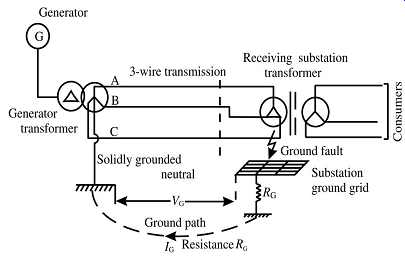AMAZON multi-meters discounts AMAZON oscilloscope discounts
..
1. Introduction
The previous section dealt with the grounding of neutral point of electrical systems at the source of power. In this section we will learn about the whys and hows of grounding of electrical equipment at the point of utilization.
The basic objectives of grounding of electrical equipment enclosures are as follows:
• To reduce electric shock hazards to personnel
• To provide a low-impedance return path for ground fault currents to the power source so that the occurrence of fault can be sensed by the circuit protective devices and faulty circuit can be safely isolated
• To minimize fire or explosion hazard by providing a ground path of adequate rating, matching the let through energy by circuit protective devices
• To provide a path for conducting away leakage current (small currents flowing through electrical protective insulation around live conductors) and for accumulated static charges (covered in a later section). We will review each of these functions in the subsequent paragraphs.
2 Shock hazard
The human body presents a certain amount of resistance to the flow of electric current.
This however is not a constant value. It depends on factors such as body weight and the manner in which contact occurs and the parts of the body that are in contact with the earth. FIG. 1 illustrates this point.
If the flow of current through the human body involves the heart muscles, it can produce a condition known as fibrillation of the heart denoting cardiac malfunction. If allowed to continue, this can cause death. The threshold of time for which a human body can withstand depends on the body weight and the current flowing through the body. An empirical relation has been developed to arrive at this value:
Ts= S_B/(I_B)^2
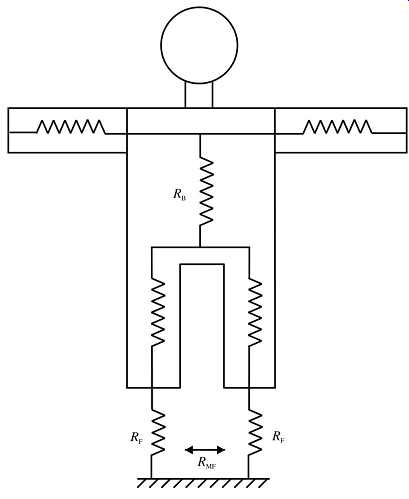
FIG. 1 Resistance of human body to current flow.
where TS is the duration of exposure in seconds (limits of 0.3 and 3 s), IB is the RMS magnitude of current through the body and SB is the empirical constant.
Using this relation and assuming a normal body weight of 70 kg, it can be calculated that:
I_B = 0.157 / sqrt T_S
... where IB is the RMS magnitude of current through the body (A) and TS is the duration of exposure in seconds (decided by the operation of protective devices).
This value, however, has to be used with care. For example, a considerable portion of the body resistance is due to the outer skin. Any loss of skin due to burning in contact with electrical conductors can lower the resistance and increase the current flow to dangerous values.
In general, two modes of electrical potential application can happen. The first case is when a person is standing on the ground and touching an electrically live path. The other is the case of a potential difference between two points on the ground being applied across the 2 ft with the distance being about 1 m. Refer FIG. 2, which illustrates these conditions.
Since the human body presents different values of resistance to the flow of electricity in these two modes, the voltage limits for tolerance of human body are calculated individually for both cases as follows.
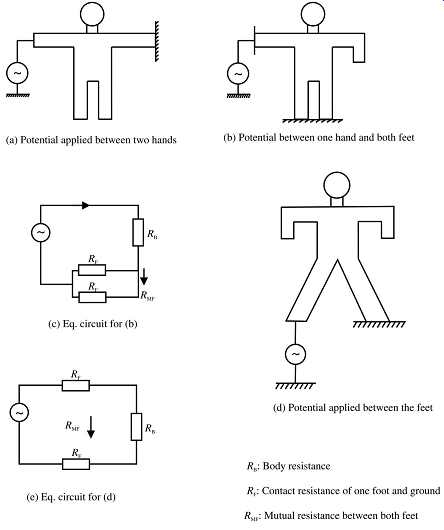
FIG. 2 Modes of application of electric potential
Case 1 Contact with live part by hand
AB FMF = + 0.5( + ) RR RR
where RA is the touch voltage circuit resistance (ohm), RB is the body resistance (taken as 1000 ohm), RF is self-resistance of each foot to remote earth in ohms and RMF is the mutual resistance between the feet in ohms.
Case 2 Contact with feet AB F MF = + 2 2 R RR R -
...where RA is the step voltage circuit resistance in ohms, RB is the body resistance taken as 1000 ohm, RF is the self-resistance of each foot to remote earth in ohms and RMF is the mutual resistance between feet in ohms.
The type of contact that normally happens in a building or other consumer installations is mostly of first mode. The voltage of tolerance in this mode as calculated in case 1 is called as touch potential. The occurrence of the second mode of contact is specific to outdoor electrical substations with structure mounted equipment and therefore is not much of relevance in our discussions. The voltage value arrived at for case 2 is known as step potential.
It therefore follows that the design of commercial, industrial and domestic electrical installations and their grounding methods should be done with due consideration to touch potential that can arise during abnormal or fault conditions.
3 Grounding of equipment
Electrical equipment grounding is primarily concerned with connecting conductive metallic enclosures of the equipment, which are not normally live to the ground system through conductors known as grounding conductors. For the grounding to be effective, the fault current (in the event of a failure of insulation of live parts within the equipment) should flow through the equipment enclosure to the ground return path without the enclosure voltage exceeding the touch potential. This is also applicable to other parts that are normally dead (refer FIG. 3).

FIG. 3 Voltage pattern during ground fault
The touch potential in such a case can be calculated by the application of Ohm's law: touch G G VIZ =×
...where IG is the maximum ground fault current that is expected to flow and ZG is the impedance of the ground return path.
Ig is usually determined by the type of system grounding adopted and the protective devices that are used for fault detection and isolation.
From the above, it will be clear that the impedance of the grounding conductor between the enclosure and the groundmass should be limited to a value as low as practically achievable in order to avoid dangerous potential levels appearing on the enclosures. This will ensure that accidental human contact with these enclosures won’t result in fatal electrocution or serious injuries.
Another point to note is that in the case of a remote source without direct connection of metallic ground return path, the ground fault currents tend to flow through the groundmass. This causes an elevation of groundmass potential at the receiving end.
Since the touch voltage is between enclosure and local groundmass, it’s not of relevance as far as human safety is concerned (refer to FIG. 4 for illustration). This condition is more relevant to three-wire systems in medium voltage systems where usually metallic ground return paths between source and receiving equipment are absent. In most low-voltage applications, this is not likely to be the case. In any case, the point to be remembered is that the potential rise of the enclosure with reference to local groundmass is what essentially matters to render the system safe, regardless of other issues involved.
4 Operation of protective devices
When a fault to an enclosure takes place in electrical equipment, the return path through the groundmass alone is insufficient to operate the protective devices such as over-current release or fuses. This is so because the impedance between the enclosure and the groundmass is usually high enough to severely restrict the flow of fault currents, which is particularly true in low-voltage systems that are in common use. In these cases, it’s imperative that a low-impedance ground return path to the source is available so that fault current of adequate magnitudes to cause operation of protective devices is ensured. The grounding conductor fulfills this function of a low-impedance connection. FIG. 5 illustrates the point.
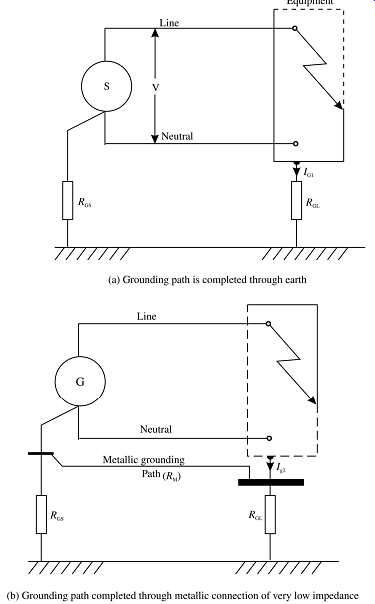
FIG. 5 Importance of ground return path
5 Thermal capability
It’s essential that the grounding conductor mentioned in the previous paragraph or any other circuit component, which serves this function, should be designed to withstand the resulting fault current without developing excessive temperature or causing sparking at the joints. This will happen if the joints in the conductor or other bonding connections are improperly executed. This condition must be true for the magnitude and duration of the current required for protective devices to operate and isolate the faulty circuit.
It’s therefore necessary to ensure good quality workmanship in these installations as otherwise the high temperatures or sparking may cause fires in the premises where they are installed. Particular care is needed in the case of installations where hazardous or inflammable materials/mixtures are present.
6 Touch potential during ground faults
As we saw earlier in this section, the touch potential that can develop on any enclosure is the product of the ground fault current and the impedance of grounding path. The current value is usually determined by the choice of neutral grounding method adopted. The impedance is a function of ground conductor resistance (determined by the conductor size) and reactance (which depends on the spacing between the phase conductor contributing to the fault and the ground conductor).
The IEEE:142:1991 discusses this in detail and has provided tables that illustrate the dependence of touch potential on conductor spacing. FIG. 6 shows the details extracted from this standard. A ground fault current of 5 kA has been assumed for arriving at these values, which can be reasonably expected in solidly grounded low voltage systems at the consumer end. Also, such circuits are not usually provided with sensitive ground fault protection and rely on over-current releases and fuses, in which case fault currents of this magnitude are required to operate protective devices within reasonable time interval.
Spacing (inches) ; Spacing (mm); Touch Voltage (V)

FIG. 6 Relation between touch potential (far end of ground conductor)
and conductor spacing
As can be noticed from FIG. 6, increased spacing between phases and grounding conductors causes unacceptable levels of touch voltage to appear on the enclosure of faulted equipment.
7 Induced voltage problem
The spacing between the phases and grounding conductor can also cause another problem.
The magnetic flux, which is generated when ground fault current flows through the system can induce voltages in any nearby looped conductor with which it has a coupling. It’s not necessary that this loop should be in physical contact with the electrical conductors. Mere magnetic linkage will be sufficient for this induction. FIG. 7 shows this condition.
The voltage thus induced may not be very high but can drive a high current if this loop is closed by itself. In the above example, currents of 500 A and an open circuit voltage of 2.5 V can typically appear. The energy content of this induction will be enough to cause an explosion or fire if suitable explosive mixtures are present in the immediate environment.
In cases where high earth fault currents are of the order of 50 kA (typically outdoor substations of solidly grounded type), dangerous potential may appear across open ends of the loop and can pose an electrical hazard. This discussion illustrates the need for proper planning for running the grounding conductors so that touch potential and induced current hazards are eliminated.
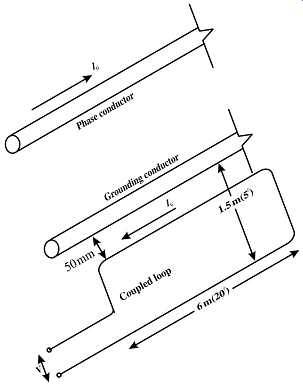
FIG. 7 Example of induced potential
8 Mitigation by multiple ground connection
One way of mitigating the problem is by bonding the ground conductor at different points to the building structures. This will prevent the voltage becoming very high by providing multiple earth return paths. But this has the effect of transferring part of the potential to building structures. In other words, potential differences may be observed between different points of the building structures. Also, the partial flow of fault currents through joints in the structure that are not meant to conduct currents may cause heating or sparking during faults. This solution has therefore to be applied with adequate caution.
For example, when reinforced concrete members are used for grounding purposes, it should be ensured that all reinforcing rods are properly connected together and joined with exothermic welds to the grounding earth conductor buried around the building.
Proper attention to detail during the design and construction of high-rise buildings can result in very low grounding impedances on almost every floor in a tall building.
9 Mitigation by reduction of conductor spacing
Since the touch potential during faults is dependent on the spacing between ground return conductor and the phase conductor, it follows that a reduction of spacing will have the effect of reducing the touch potential. One way to do this is to run the grounding conductor bundled with the phase conductors. This will cause the reactance of the ground path to become very low.
Another way is to arrange the ground conductor as a metallic sleeve surrounding the phase conductor. Besides reducing the reactance of the ground path, this has the effect of canceling the magnetic flux and preventing any induced voltages from appearing in external loops as discussed earlier in this section.
This approach is the basis for using the metal raceway as the ground conductor. Use of high section rigid steel conduits as grounding conductors has the effect of reduction of touch potential and elimination of magnetically induced voltages in external circuits.
The following, however, needs attention:
• Excessive raceway lengths can cause problems by increasing the drop along the grounding path and by reducing the flow of fault currents.
• Raceway joints should be made without introducing any appreciable electrical resistance.
• The raceway should have adequate cross-sectional area for carrying ground fault currents for the length of time required for protection operation.
It’s also possible to have a dedicated grounding conductor running along with the phase conductors within a metallic raceway, which also acts as a parallel ground return path which can mitigate some of the problems cited above.
10 EMI suppression
One of the unplanned benefits of using a metallic conduit as grounding conductor and as wiring raceway is that any electrical noise emanating from the electrical system conductors will get suppressed. The conduit acts like a screen for electromagnetic flux, which get trapped within the screen and does not radiate outside the enclosure.
This is of particular relevance in modern electrical systems where use of power semiconductors creates harmonic current flow through the system as well as line voltage notching, which can act as noise source by radiation from electrical power conductors. When the conductors supplying power to such equipment are enclosed within the metallic raceway, such electromagnetic interference (EMI) automatically gets suppressed.
11 Metal enclosures for grounding conductors
The earlier discussion was about the use of metallic raceway surrounding the phase conductors as grounding conductors for improved performance. But the use of a protective metallic sleeve around a grounding conductor from the service ground point to a grounding electrode presents a different problem.
These conductors carry current only when there is a ground fault and carry current one way.
The other part of the current flows in a different circuit remote from the grounding conductor.
Providing a steel protective sleeve, which is a magnetic material around this conductor, has the effect of increasing the reactance of the conductor by a factor of about 40. Take, for example, a coil wound on a former without core connected to an AC supply.
Now put a magnetic core within the former. You will notice that the current drops sharply because of the increased inductance. The pipe sleeve behaves in a similar fashion as the core (refer FIG. 8).
To avoid this problem, it’s necessary to bond the grounding conductor at both entrance and exit points with each integral section of the metallic enclosure. This results in reduction of impedance and therefore the voltage drops. Simultaneously, the metal sleeve also acts as a parallel grounding conductor and causes the voltage drop to reduce further (refer FIG. 9).

FIG. 8 Coil with and without a core
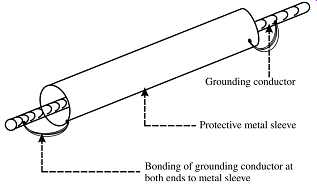
FIG. 9 Bonding of earth conductor within a pipe sleeve
12 Grounding connections for surge protection equipment
Special care is necessary for conductors that connect surge suppression equipment ground leads with ground electrodes. When the surge suppressors act to conduct line surges to ground, a steep fronted current wave passes through the device to ground. The voltage of the grounding terminal will depend on the inductance of the grounding conductor, which in turn depends on its length. For a typical lightning surge with a rate of rise of typically 10 kA/µs, the voltage drop in the length of the grounding conductor is substantial. The voltage on the terminals of the equipment, which is to be protected, is the sum of the lightning surge suppressor's breakdown voltage and the voltage drop in the grounding wire. FIG. 10 illustrates this principle (a practical example of the importance of this principle has been explained in Section 10).

FIG. 10 Ground connection of surge suppressor of a transformer.
13 Sensing of ground faults
A sensitive protection for ground faults will use one of the following approaches:
• In case the power supply source (such as the transformer) is a part of the system, a CT and relay can be provided in the ground connection of the neutral of the transformer ( FIG. 11a).
• By a single current transformer enclosing all phase and neutral conductors (called as core balance or zero sequence CT). Such a transformer detects the ground fault currents and can operate a sensitive relay ( FIG. 11b).
• By individual current transformer in phase and neutral conductors and providing a relay in summation circuit ( FIG. 11c).
• Adding special ground fault equipment to the system to sense even low value of earth fault currents and trip the circuit faster.
Inclusion of the neutral in FIGs. 11b and c is for canceling any unbalance currents that may flow in the neutral from being sensed as ground faults.

FIG. 11 Sensitive ground fault protection connections
14 Equipotential bonding
Equipotential bonding is essentially an electrical connection maintaining various exposed conductive parts and extraneous conductive parts at substantially the same potential. An earthed equipotential zone is one within which exposed conductive parts and extraneous conductive parts are maintained at substantially the same potential by bonding, such as that, under fault conditions, the difference in potential between simultaneously accessible exposed and extraneous conductive parts won’t cause electric shock.
Bonding is the practice of connecting all accessible metalwork - whether associated with the electrical installation (known as exposed metalwork) or not (extraneous metalwork) - to the system earth. In a building, there are typically a number of services other than electrical supply that employ metallic connections in their design. These include water piping, gas piping, HVAC ducting, and so on. A building may also contain steel structures in its construction. We have seen earlier in this section that when an earth fault takes place in an installation, the external conducting surfaces of the installation and the earth mass in the vicinity may attain higher potential with reference to the source earth. There is thus a possibility that a dangerous potential may develop between the conducting parts of non-electrical systems including building structures and the external conducting parts of electrical installations as well as the surrounding earth. This may give rise to undesirable current flow through paths that are not normally designed to carry current (such as joints in building structures) and also cause hazardous situations of indirect shock. It’s therefore necessary that all such parts are bonded to the electrical service earth point of the building to ensure safety of occupants. This is called equipotential bonding.
There are two aspects to equipotential bonding: the main bonding where services enter the building and supplementary bonding within rooms, particularly kitchens and bathrooms.
Main bonding should interconnect the incoming gas, water and electricity service where these are metallic but can be omitted where the services are run in plastic, as is frequently the case nowadays. Internally, bonding should link any items, which are likely to be at earth potential or which may become live in the event of a fault and which are sufficiently large that they can contact a significant part of the body or can be gripped. Small parts, other than those likely to be gripped, are ignored because the instinctive reaction to a shock is muscular contraction, which will break the circuit. In each electrical installation, main equipotential bonding conductors (earthing wires) are required to connect to the main earthing terminal for the installation of the following:
- • Metal water service pipes
- • Metal gas installation pipes
- • Other metal service pipes and ducting
- • Metal central heating and air-conditioning systems
- • Exposed metal structural parts of the building
- • Lightning protection systems.
It’s important to note that the reference above is always to metal pipes. If the pipes are made of plastic, they need not be main bonded. If the incoming pipes are made of plastic but the pipes within the electrical installation are made of metal, the main bonding must be carried out, the bonding being applied on the customer side of any meter, main stopcock or insulating insert and of course to the metal pipes of the installation. Such bonding is also necessary between the earth conductors of electrical systems and those of separately derived computer power supply systems, communication, signal and data systems and lightning protection earthing of a building. Many equipment failures in sensitive computing and communication equipment are attributable to the insistence of the vendors to keep them separated from the electrical service earth. Besides equipment failures, such a practice also poses safety hazards particularly when lightning discharges take place in the vicinity. In such cases, large potential difference can arise for very short periods between metal parts of different services unless they are properly bonded. Some of the case studies in a later section deal with this issue.
If the incoming services are made of plastic and the piping within the building is of plastic, then no main bonding is required. If some of the services are of metal and some are plastic, then those that are of metal must be main bonded. Supplementary or additional equipotential bonding (earthing) is required in locations of increased shock risk. In domestic premises, the locations identified as having this increased shock risk are rooms containing a bath or shower (bathrooms) and in the areas surrounding swimming pools.
There is no specific requirement to carry out supplementary bonding in domestic kitchens, washrooms and lavatories that don’t have a bath or shower. That is not to say that supplementary bonding in a kitchen or washroom is wrong but it’s not necessary. For plastic pipe installation within a bathroom, the plastic pipes don’t require supplementary bonding, and metal fittings attached to these plastic pipes also would not require supplementary bonding. However, electrical equipment still does require to be bonded and if an electric shower or radiant heater is fitted, they will require supplementary bonding as well.
Supplementary bonding is carried out to the earth terminal of equipment within the bathroom with exposed conductive part. A supplementary bond is not run back to the main earth. Metal window frames are not required to be supplementary bonded unless they are electrically connected to the metallic structure of the building. Metal baths supplied by metal pipes don’t require supplementary bonding if all the pipes are bonded and there is no other connection of the bath to earth. All bonding connections must be accessible and labeled: SAFETY OF ELECTRICAL CONNECTION - DO NOT REMOVE.
15 Summary
In this section, we learnt about the basic issues of electric shock hazards. We reviewed the need for providing grounding connections to electrical equipment and the methods adopted for grounding. We discussed the ways and means of limiting the potential on equipment enclosures to safe values by proper ground connections. We also learnt how sensitive earth fault protection can be provided and where such protection is likely to be required. Information regarding grounding of substations and equipotential bonding of residential buildings was also covered. The salient provisions of various international codes relating to grounding and analysis of grounding behavior in MV/LV systems are discussed in sect. A and they may be referred for additional information.
